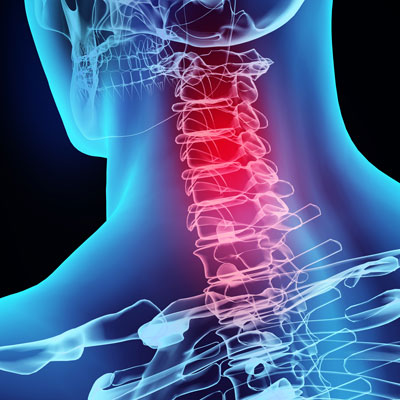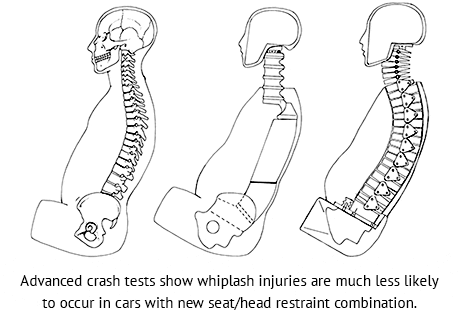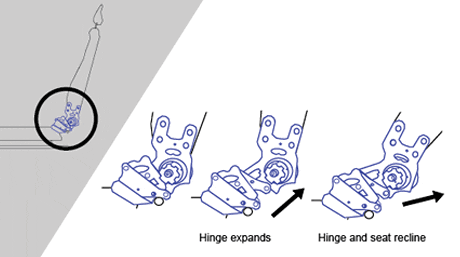New Seat/Head Restraints and Whiplash Injuries
By Matthew J. DeGaetano, DC and Adam Shafran, DC
The first U.S. crash tests conducted with the world’s most advanced rear impact d

ummy demonstrate that the new seatback/head restraint combination in Volvo S80s successfully reduces the sudden motion of the head relative to the torso that causes many whiplash injuries. The new design represents an improvement even when compared with other Volvo seatback/head restraint combinations, which are among the best designs for whiplash injury prevention.
“The new design in the S80 is an important advancement because neck injuries occur so often in car crashes. They cause pain for many motorists, and they cost society billions of dollars every year,” Insurance Institute for Highway Safety President Adrian Lund points out.
Recent research indicates that many of the whiplash injuries with prolonged symptoms occur in rear impacts in which the sudden forward acceleration of an occupant’s torso causes the neck to change shape because the head doesn’t move with the torso. Volvo’s new seat is designed to prevent such injuries by reducing the forward acceleration of the torso and catching the head early in the crash with a good head restraint.
Crash test results
Institute researchers conducted joint crash tests with Volvo to evaluate the automaker’s new seatback/head restraint design, dubbed WHIPS for whiplash injury prevention system. One other manufacturer, Saab, also offers an advanced seatback/head restraint combination, which the Institute hasn’t yet evaluated in crash tests.
Note: The Neck Injury Criterion (NIC) is a measure of neck injury risk that can be recorded on advanced crash test dummies. Specifically, NIC measures the differential movement of the head and torso that produces certain types of neck injuries. Researchers have proposed a NIC of 15 as the threshold below which the chances of whiplash injury with prolonged symptoms are very low. The higher the NIC above 15, the greater the chances of injury.
Neck injury criteria in 15 MPH rear crash tests
In three crash tests conducted to evaluate WHIPS, a Volvo S80 was struck in the rear by a 4,000 pound barrier moving at 15 mph. Advanced BioRID dummies were seated in the front driver and passenger seats. In the first test, the S80’s WHIPS passenger seatback was replaced by an S70 seatback without WHIPS. In the second test, the driver seat was replaced. The configuration of the seats in the third test was the same as in the first one.
In all three crash tests, the BioRID dummies in the seats with WHIPS recorded neck injury criteria (NICs) that were lower than 15. In contrast, the BioRID dummies in the seats without the special WHIPS design recorded higher NICs (21 to 23).
“These results are clear,” Lund says. “They leave no doubt that WHIPS does a better job than even a good conventional seatback/head restraint combination in reducing the sudden relative motion of the head and neck that causes many whiplash injuries.”
How WHIPS works
WHIPS includes two components designed to limit the sudden differential motion of the head and neck. The unique feature is a hinge at the bottom of the seatback that allows it to move rearward to reduce the forward acceleration of the torso. Then the head restraint, which is positioned high enough and close enough to the back of the head, catches the head so that it moves forward with the torso. The combination of the slower torso acceleration and the head restraint catching the head early in the sequence means the neck changes shape less — and the change occurs more slowly — than with a conventional seatback/head restraint. The result is that a whiplash injury is less likely to occur.
Importance of new crash test dummy, injury criterion
Before the introduction of NIC and the new BioRID dummy used to evaluate WHIPS, researchers’ ability to measure whiplash injury risk in crash tests was limited because the widely used Hybrid III dummy’s neck isn’t very humanlike. Its lower spine isn’t flexible, and its neck doesn’t move like a human’s. Another limitation was that no criterion had been established to indicate neck injury likelihood in crash tests.
Given these limitations, it was difficult to assess how well seatback/head restraint combinations would perform in real crashes. Researchers were limited to measuring head restraint geometry — an important assessment because, for any whiplash protection system to be effective, the restraint has to be behind and close to the back of an occupant’s head as the seat is accelerated forward in a rear impact. When Institute researchers measured the head restraints in more than 200 passenger vehicles, they found only 3 percent of all 1997 models with good head restraint/seatback geometry. Among these few models were Volvos.
“But preventing whiplash injuries is only partly addressed by a head restraint with good geometry. In fact, good geometry is necessary, but other characteristics of the seatback and head restraint also can influence injury risk,” Lund explains. “Dynamic seatback performance — that is, how a seatback deforms in a crash — also is important. This is why the new crash test dummy and NIC are so important. They allow us to conduct more complete dynamic assessments of seatback/head restraint systems like WHIPS.”
Volvo has a history of making cars with superior head restraints, “so it’s not surprising it would be a leader along with Saab in introducing active head restraint systems,” O’Neill also says. “The bottom line is that now we have much better tools than before to assess whiplash injury risk in dynamic tests, and we’ve evaluated a head restraint/seatback system that’s better than even the good restraints we’ve seen before. As more and more automakers are belatedly paying attention to head restraint designs, we hope these findings will spur even more progress.”
ADDITIONAL INFORMATION
What are whiplash injuries?
They typically are relatively minor neck injuries that occur frequently in crashes. Although whiplash injuries can occur in any kind of crash, they occur most often in rear-end collisions. The vehicle that’s struck in the rear is accelerated forward, causing the seats to push against occupants’ hips and backs, accelerating them forward. If an occupant’s head is unsupported, it tends to lag behind as the torso is accelerated forward. This causes the neck to change shape, first taking on an s-shape and then bending backward. Eventually, the forces on the neck accelerate the head, which catches up with — and, if the occupant is using a shoulder belt, passes — the torso. This motion of the head, which is like the lash of a whip, gives the resulting neck injuries their popular name.
Whiplash injuries can range from mild muscle strain to tearing of various soft tissues in the neck — for example muscles, ligaments, or nerves. The symptoms associated with these injuries range from soreness lasting several hours to headaches, pain, nausea, decreased range of motion, or tingling in the arms and legs that can last several months or more. While different names are attached to various combinations of these symptoms, all are commonly referred to as whiplash. In many cases, the symptoms don’t occur until hours after the crash.
How do whiplash injuries occur?
There’s universal acceptance that the injury source is sudden differential movement of the head, neck, and torso. However, the actual injury mechanisms aren’t fully understood. For a long time, it was thought that extreme hyperextension of the neck was the cause — the neck begins pulling the head forward, straining the muscles, tendons, or ligaments of the neck and causing the tissues to tear. This still may explain many whiplash injuries with symptoms lasting a few days or weeks. The brief soreness and decreased range of motion are consistent with strains from other activities — sports, for example — where the tissue damage is better documented. Magnetic imaging can sometimes, but not always, confirm such damage to muscles, tendons, or ligaments.
However, damage to muscles, tendons, or ligaments doesn’t account for all whiplash injuries, especially the ones that last longer than a few days or weeks. These injuries involve more serious symptoms, which may include tingling and numbness in the arms and legs and/or chronic pain that can last for months. Such symptoms appear to be caused by damage to the nerve tissue.
Research at Chalmers University of Technology in Sweden has shown that damage to the nerves entering the spinal column can occur with rapid changes in spinal column pressure. When the head moves back, relative to the torso, the shape of the neck changes. This increases or decreases the interior volume of the spinal column but, because spinal fluid is incompressible, the changes in the spinal column volume result in pressure changes. Under normal circumstances — when you nod your head, for example — there’s time for the fluid to move into or out of the spinal column to equalize the pressure. No injury occurs. But in a rear impact, changes in the spinal column volume can be too rapid for normal fluid exchanges to occur, and the resulting pressure damages the nerve fibers where they enter the spinal column. This research indicates that a critical issue isn’t the extent of the neck motion — it’s the speed at which the motion occurs.
What is NIC?
The Neck Injury Criterion (NIC) is a measure of neck injury risk that can be recorded on advanced crash test dummies. NIC doesn’t measure spinal column pressure directly but, as a surrogate, it compares the speed and acceleration of the head at the top of the neck with the speed and acceleration of the first thoracic vertebra at the bottom of the neck. This indicates how much the head motion is delayed behind the torso motion. Lower NIC values indicate shorter delays. The comparison is expressed in terms of meters per second, squared.
NIC is based on tests involving pigs. Researchers at Chalmers University of Technology in Sweden recorded significant spinal column pressure changes in tests that also caused nerve damage to pigs. The type of nerve damage the researchers observed could explain the kinds of symptoms suffered in human cases of whiplash injury with long-term symptoms. Based on research with both pigs and humans, the Swedish researchers have proposed a value of 15 as the threshold below which the chances of whiplash injury with prolonged symptoms are very low.
NIC holds promise as the first injury measure to assess the risk of nerve damage from whiplash motion. As more research is conducted, more will be known about how the studies involving the pigs relate to human injuries and whether NIC can be used to predict injuries other than nerve damage that also are associated with whiplash.
What is BioRID?
BioRID, or biofidelic (humanlike) rear impact dummy, is a new crash test dummy designed especially to study the relative motion of the head and torso in rear crashes. The difference between BioRID and Hybrid III, the most widely used crash test dummy, is that BioRID’s spine is composed of 24 vertebra-like pieces. BioRID’s neck moves much more like a human’s than does the Hybrid III’s. Plus BioRID’s segmented thoracic spine is flexible, like a human’s, so it interacts with vehicle seats in a more humanlike way, compared with the Hybrid III’s rigid spine. Most important is that BioRID’s segmented neck can produce the s-shape observed in human necks during rear crashes. The pressure changes in the human spinal column as the neck assumes this s-shape are believed to cause many whiplash injuries.

The 24 vertebrae in the BioRID’s spine are connected by pin joints similar to door hinges. This arrangement works well for modeling pure front-to-rear motions but doesn’t allow the side-to-side motions of which humans are capable. The front-to-rear range of motion between adjacent vertebrae in the dummy has been matched to the range of motion reported in scientific literature on human anatomy. The resistance to motion at each of the 25 joints is controlled by specially formulated urethane rubber blocks. And the neck segments, which represent the cervical vertebrae, are connected by two cables, which are attached to a spring/damper mechanism that acts like human neck muscles. Tests comparing both BioRID and Hybrid III to human volunteers in very low-speed crash simulations indicate that BioRID moves much more like a human than does Hybrid III.
Developed in Sweden by researchers at Chalmers University of Technology, BioRID evolved from an earlier neck, called RID-neck, which was designed to fit on a Hybrid III’s spine. But early tests using Hybrid IIIs equipped with the RID-neck didn’t compare well enough with human volunteer tests to reliably assess some aspects of whiplash motion and whiplash protection systems. This is why BioRID evolved. Currently, only four prototypes of this dummy exist.
How does WHIPS work?
Volvo’s whiplash protection system (WHIPS) is designed to prevent whiplash injuries by reducing the relative motion of an occupant’s head and torso in a rear crash. There are two important WHIPS components. The first is a seat hinge that controls the force of the seatback against the occupant’s torso so that the torso accelerates more gently — that is, the seatback and the occupant’s torso accelerate more slowly than the car. The other important component is a head restraint that’s high enough and close enough to the back of an occupant’s head to catch it before the torso has moved so far that the neck suddenly changes shape. The combination of the slower torso acceleration and the head restraint catching the head early in the sequence results in NIC values that are lower than would be experienced with conventional seatbacks and head restraints.

How Volvo WHIPS seat works
The special hinge in the WHIPS seat controls the force applied to an occupant’s hips and back by bending in a controlled manner. After a rear crash in which WHIPS has been activated, the seatback will be displaced from its original position because the hinges will be deformed. The special WHIPS hinges can easily be replaced when other car repairs are made.



